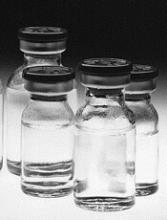Denosumab can be effective against osteoporosis caused by transfusion-dependent thalassemia (TDT), according to research published in Blood Advances.
Researchers found that patients who received twice-yearly injections of denosumab experienced a significant increase in bone density and reduction in bone pain.
“Not only is denosumab associated with improved bone health and reduced pain, but its ease of administration may very well make this drug superior to bisphosphonates for the treatment of osteoporosis in patients with TDT and osteoporosis,” said study author Evangelos Terpos, MD, of the National and Kapodistrian University of Athens in Greece.
For this phase 2b study, Dr. Terpos and his colleagues evaluated 63 patients with TDT and osteoporosis.
They were randomized (in a double-blinded fashion) to receive 60 mg of denosumab (n=32) or placebo (n=31) on days 0 and 180 of a 12-month period. Patients in both arms also received daily supplements of calcium and vitamin D.
Baseline characteristics were largely similar between the treatment arms.
However, the mean value of bone-specific alkaline phosphatase (bALP) was significantly lower in the placebo arm than the denosumab arm—68.48 IU/L and 85.45 IU/L, respectively (P=0.013).
And the mean value of the tartrate-resistant acid phosphatase isoform-5b (TRACP-5b) marker was significantly higher in the denosumab arm than in the placebo arm—0.42 IU/L and 0.16 IU/L, respectively (P=0.026).
Results
The researchers measured bone mineral density in the L1-L4 lumbar spine, the wrist, and the femoral neck.
At 12 months, the mean increase in L1-L4 bone mineral density was 5.92% in the denosumab arm and 2.92% in the placebo arm (P=0.043).
The mean decrease in wrist bone mineral density was -0.26% and -3.92%, respectively (P=0.035).
And the mean increase in femoral neck bone mineral density was 4.08% and 1.96%, respectively (P=0.870).
Patients in the denosumab arm had a significant reduction in bone pain at 12 months, according to the McGill-Melzack scoring system and Huskisson’s visual analog scale (P<0.001 for both).
However, there was no significant change in pain for patients in the placebo arm (P=0.356 with Huskisson’s and P=0.768 with McGill-Melzack).
At 12 months, patients in the denosumab arm had experienced a significant reduction from baseline (P<0.001 for all) in several markers of bone remodeling, including:
- Soluble receptor activator of nuclear factor kappa-B ligand (sRANKL)
- Osteoprotegerin (OPG)
- sRANKL/OPG ratio
- C-terminal crosslinking telopeptide of type I collagen (CTX)
- TRACP-5b
- bALP.
There were no significant changes in dickkopf-1 (Dkk-1), sclerostin, or osteocalcin (OC) in the denosumab arm.
In the placebo arm, patients had a significant increase from baseline in several markers of bone remodeling, including sRANKL, OPG, Dkk-1, sclerostin, CTX, TRACP-5b, and bALP (P<0.001 for all). There was no significant change from baseline in the sRANKL/OPG ratio or OC.
In all, there were 17 adverse events (AEs) in 14 patients.
There were three grade 1 AEs in the placebo arm and 11 in the denosumab arm. Most grade 1 AEs in the denosumab arm were test abnormalities, although three were not—headache, diarrhea, and fever.
There were three serious AEs in the denosumab arm as well—pleural effusion (grade 3), atrial fibrillation (grade 3), and supraventricular tachycardia (grade 4). All three of these AEs were considered unrelated to denosumab.
This study was funded by Amgen, which markets denosumab as Xgeva. The authors said they had no competing financial interests.


